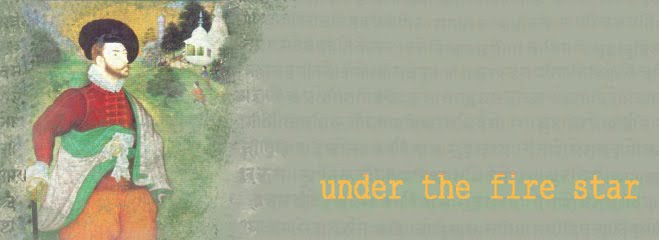From my journal -- a visit to an astrologer in Calcutta:
On the way back from Dakshineshwar D said, "My astrologer lives near here. It's just five minutes away. We'll go and visit him." I said, "Will he tell me good things?" He answered, "He's a very old man, and very good, and he only says good things."
It was getting dark as he turned into a crowded area of small cement houses, with winding lanes barely wide enough for the car to pass. It was a neighbourhood for people who owned motorcycles. He parked in a cul-de-sac beside a two-story house, one room wide and perhaps two or three rooms deep. We got out of the car and D called inside, and we entered.
Panditji sat on a mat on the floor, with one knee up and one knee down. He was a skinny old man in a dirty, torn white undershirt and a torn white dhoti. On his right arm just above the elbow he wore several cords, and one chain of metal links, with charms attached to them. He wore rings with coloured stones on both hands. Several black cords hung around his neck, holding charms which were hidden beneath his undershirt. He wore thick black-framed glasses. He had big eyes in a thin face. His greying hair, through which his scalp showed, was combed straight back, and fell in thin strands halfway down his back. He sat with his head down, and occasionally glanced up from under bushy grey eyebrows.
We sat on mats. He sat beside a bed raised on bricks, under which were piles of papers, books, magazines. Next to him on the floor were steel glasses and dishes, all covered, with some drying slices of cucumber on one of the lids. Behind him were two steel cupboards set up on bricks. Under them were a number of small square paper candy boxes. I looked up from where I sat and saw the main electric switch, connecting the house to the outside lines. It was covered with cobwebs, and cobwebs hung from the ceiling. The room was lit by one neon tube light. A dirty ceiling fan was switched off. Behind me was a glass-fronted cupboard full of bulging plastic bags.
Next to the front door two glass-fronted cabinets were lit from within by electric lights. They were packed with gods. In the centre of the larger cabinet was black Kali, with her characteristic lolling tongue made of gold, and wearing gold earrings and necklace. The other gods were dusty with what looked like incense ash or vibhuti powder. In front of each god was a miniature steel plate and a tumbler the size of a large thimble. Each plate contained a fresh marigold, each tumbler was filled with water.
Coloured lithographs of deities filled every bit of available wall space. One was a calendar picture showing the head of Ramakrishna Paramahansa surrounded by a ring of Kali faces, beautiful dark blue women, smiling alluringly at him from different angles - but all with the long red tongue hanging down.
D sat beside Panditji and began talking in Bengali, explaining who we were and asking questions. Panditji pulled a book from the pile under the bed, opened it, touched a line with his finger and spoke briefly. As the darkness outside became complete, the room filled with hungry mosquitoes. We tried to wave them off, but Panditji ignored them.
It was a slow process. D asked something, Panditji gave a brief answer, there was a pause, then another question. Ramesh interjected something, at which Panditji laughed, like a cough. He asked D if I had any questions. I asked, "What sort of thing should I ask? What kind of questions do you ask?" D said, "It should be something specific." I said, "I don't know. Will I ever publish a book? How is Ramesh's health? How is my health? Are those the right kind of questions?" D said, "You can ask him directly, he knows all languages." Panditji said, in English, addressing me for the first time, "Do you want to say anything more?" I laughed, acknowledging my surprise, and he said, "Write this down." I pulled out my notebook, and he began to predict. "By September present position increase time." D translated this to mean that everything was good, and would improve after September. Ramesh's "time is running good time." He began in English, but what he had already said had pretty much exhausted him, so after awhile he switched back to Bengali and D translated for him. As D had said, he had only good things to say.
D told him a number of things about us, and advised him on his answers, which advice he took. Panditji looked at Ramesh's palm. D said, "See that cross there? Look, Venus is very strong." Panditji peered near-sightedly at Ramesh's hand and said, "Yes, it is very strong." D asked which of us would live longer, myself or Ramesh, but Panditji was discreet, and refused to answer. D said, "Will she live longer?" and he gave his coughing laugh. "Will he live longer?" A slight shake of the head, and a laugh. It was as though D were showing off the abilities of a favourite child. When I ran out Panditji said, "Any more question, Motherji?"
He pulled out one of the paper boxes, and offered us each a sweet. We declined, but D said, "I'll take it as
prasad", food blessed by God, and pinched off just a bit and ate it.
Good old man, you are dead now.
May Kali, whose avid mouth
hungers for the flesh of evil-doers
be your protection.



























